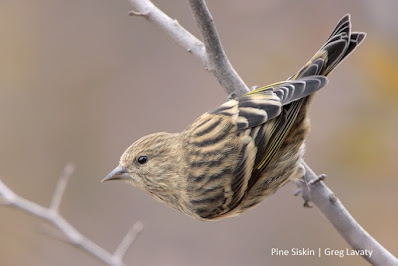Birds infected with Salmonellosis can show a number of different symptoms, from displaying swollen eyelids to acting lethargic and being slow to react. Other symptoms include sitting on the ground, appearing thin or fluffed up, and having pasted vents (feces caked under tail). Some birds, however, don’t show any outward symptoms.
Infected birds can shed bacteria at feeders and water features, turning those areas into disease vectors. If you see any indication of Salmonellosis infection in your backyard birds, take down any bird feeders or water features immediately and leave them down for a few weeks or until the Pine Siskins are gone. Bleach anything a bird could have come into contact with, and pick up any discarded seed or chaff from your backyard. If you prefer to keep the feeders up, clean and disinfect feeders daily and ensure they are completely dry before adding food. These actions will help prevent further spread of Salmonellosis through contaminated feeders and by limiting bird-to-bird contact that occurs in areas where birds gather. Though Salmonellosis is appearing at high rates in Pine Siskins, this disease can spread to any other species that share feeders with these birds. We will be posting updates with guidance from Texas Parks and Wildlife Department.
Feeder cleanliness isn’t just important during times of disease outbreak like this one, but year-round. Routine cleaning of your bird feeders and water features is important. Feeders should be thoroughly cleaned and disinfected at a minimum of 1-2 times per month, preferably weekly. To prevent overcrowding at your feeder, consider adding a few more, spread out around your backyard, including different types of feeders to encourage different species of visitors with varying feeding behaviors. Limiting other threats to birds is important all year round, but during this time when birds are potentially sick and recuperating on the ground, it is particularly important. Keeping cats indoors is vital during this time for both the safety of our birds and the health of the cats, as salmonella can transmit from sick birds into cats. Keeping an eye on dogs is important as well during this time. If you interact with birds that may be sick, be sure to thoroughly wash your hands with an anti-bacterial soap to prevent transmitting salmonella. If you have more questions about preventing Salmonellosis in your backyard, feel free to contact our Bird-Friendly Communities Program Manager, Anna Vallery, at avallery@houstonaudubon.org.Summary of Actions to Prevent Salmonellosis:
- Keep your eyes peeled for birds that appear sick or lethargic
- If you think a bird in your backyard is sick, take down and disinfect all feeders and water features immediately
- Clean up any seed shell or chaff from around your yard
- Keep cats indoors
- Keep an eye on dogs when they’re outside
- Be prepared to continue to clean and disinfect feeders and water features
- Wash hands thoroughly with anti-bacterial soap after handling sick birds to prevent transmitting salmonella
Update 3/10/21 Media Release from Texas Parks and Wildlife: Biologists Advise Cleaning Feeders to Prevent the Spread of Diseases Among Birds
Update 3/11/21
If you have found a sick bird in Houston, please put it in a box and keep it in a warm, quiet environment until you can bring the bird to one of the following rehab facilities:
Texas Wildlife Rehabilitation Coalition (713) 468-8972 - Accepting drop-offs daily between 10 am and 2 pm by appointment only.
Wildlife Center of Texas (713) 861-9453 - Accepting drop-offs daily between 10 am - 3 pm, no appointment necessary.
By Anna Vallery, Conservation Specialist, Houston Audubon






Comments
Post a Comment